The hardest thing about not holding workshops this summer is knowing that so many of you are missing out on the incredible interactions and relationships and skill building that time at Penland fosters. We believe there’s no substitute for this intense, in-person learning. But we also know that, wherever they are, our instructors are a generous group with a lot to teach and share. So, in that spirit, we’re checking in with a handful of them who would have been here teaching at the start of our summer sessions. We hope their words, images, and short videos light a creative spark in you—may you nourish it until the next time we can be together in the studios again! #PenlandEverywhere
Susan Goethel Campbell
Session 1 Drawing—Investigations in Materiality
I miss being part of the creative community at Penland this year. Since the pandemic I have been printing, making short videos and bending branches around the corners of my studio. There is something about a stick at 90-degree angle that feels so wrong and unnatural that somehow feels right. Some days I am completely focused in the studio and know where I am headed. On other days I am restless, totally lost and wander from one project to the next.
Sometimes being stuck, however frustrating, is a good thing. I have been reflective about my work, humanity and how we are all connected. My agitation has kept me moving and I have gotten back in touch with what really drives my creative practice. Exploring new materials with no particular outcome in mind is one of those places. With exhibitions postponed and projects cancelled having time to play has been a gift.
Wishing everyone good health and abundant creativity.
Andrea Donnelly
Session 1 Textiles—Woven Cloth, Raw Material
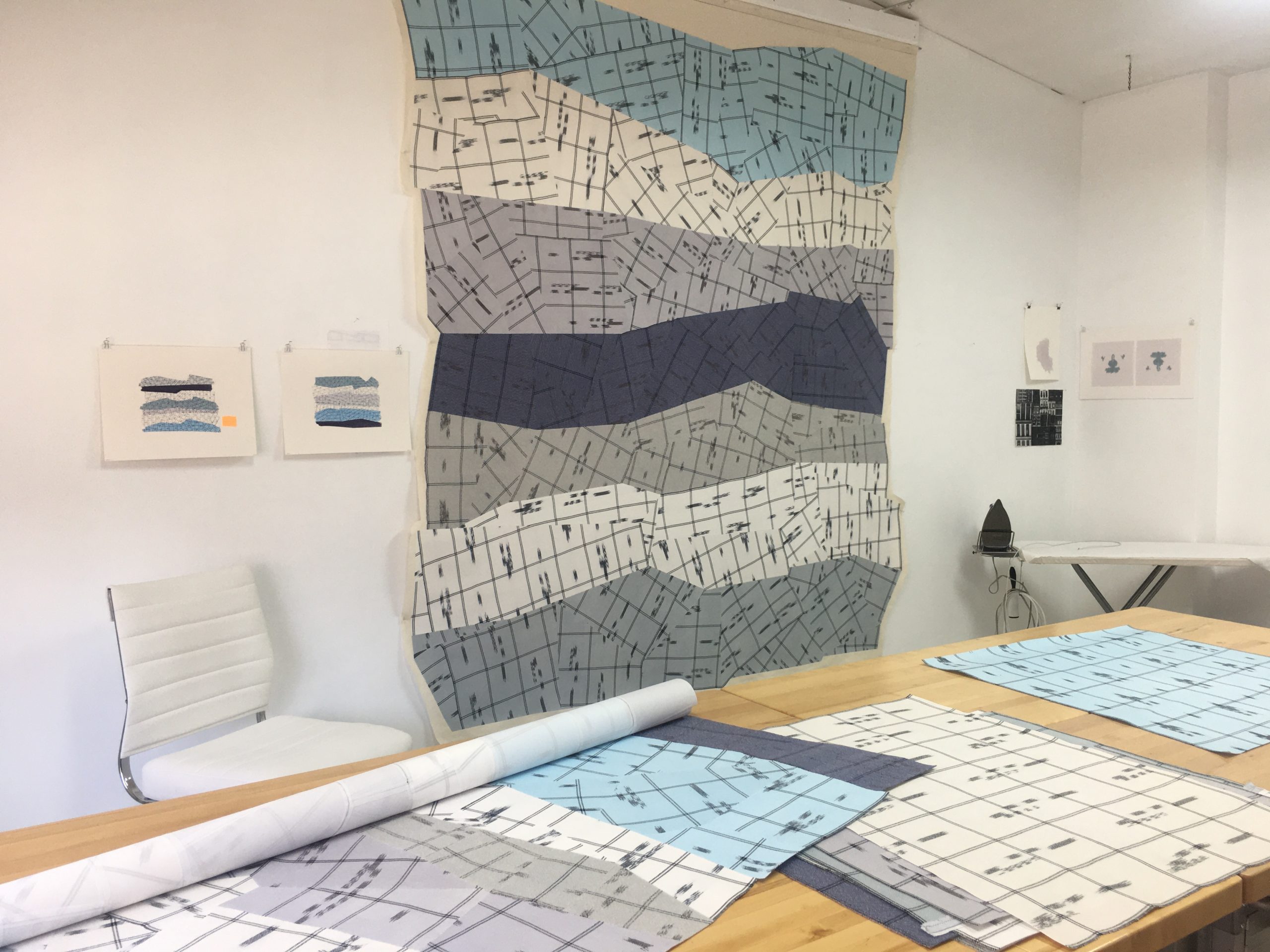
Right now I’m working on a series of three large-scale collages made from cloth I wove and dyed by hand. These works combine the slow, methodical and thoroughly planned process of weaving, which I use to create raw material for collage with the spontaneous and playful puzzle-like creation of the final piece. Because the handwoven cloth is so dense it has a real weight and presence as a material, and putting the cut pieces together truly feels like building or sculpting.
When I started this series (still working on the title), I had a few things in mind that have been guiding the work: landscape, mountains, language, atmosphere, air, ice and water, chaos and order. I began this work a few months before quarantine, with seven huge panels of handwoven cloth in whites and creams of seven different materials (cotton warp woven with: linen, alpaca, bleached cotton, natural cotton, mohair, silk, and merino), which I overdyed in seven colors. Those cloths were then divided for the three large collages: the one you see on the wall is the largest and only vertical of the three, the other two are landscape orientation. The second one is finished and partially rolled up on the table, and I’m about to start on the third from the remaining pieces!
Lynn Duryea
Session 1 Clay—Stretch the Limit
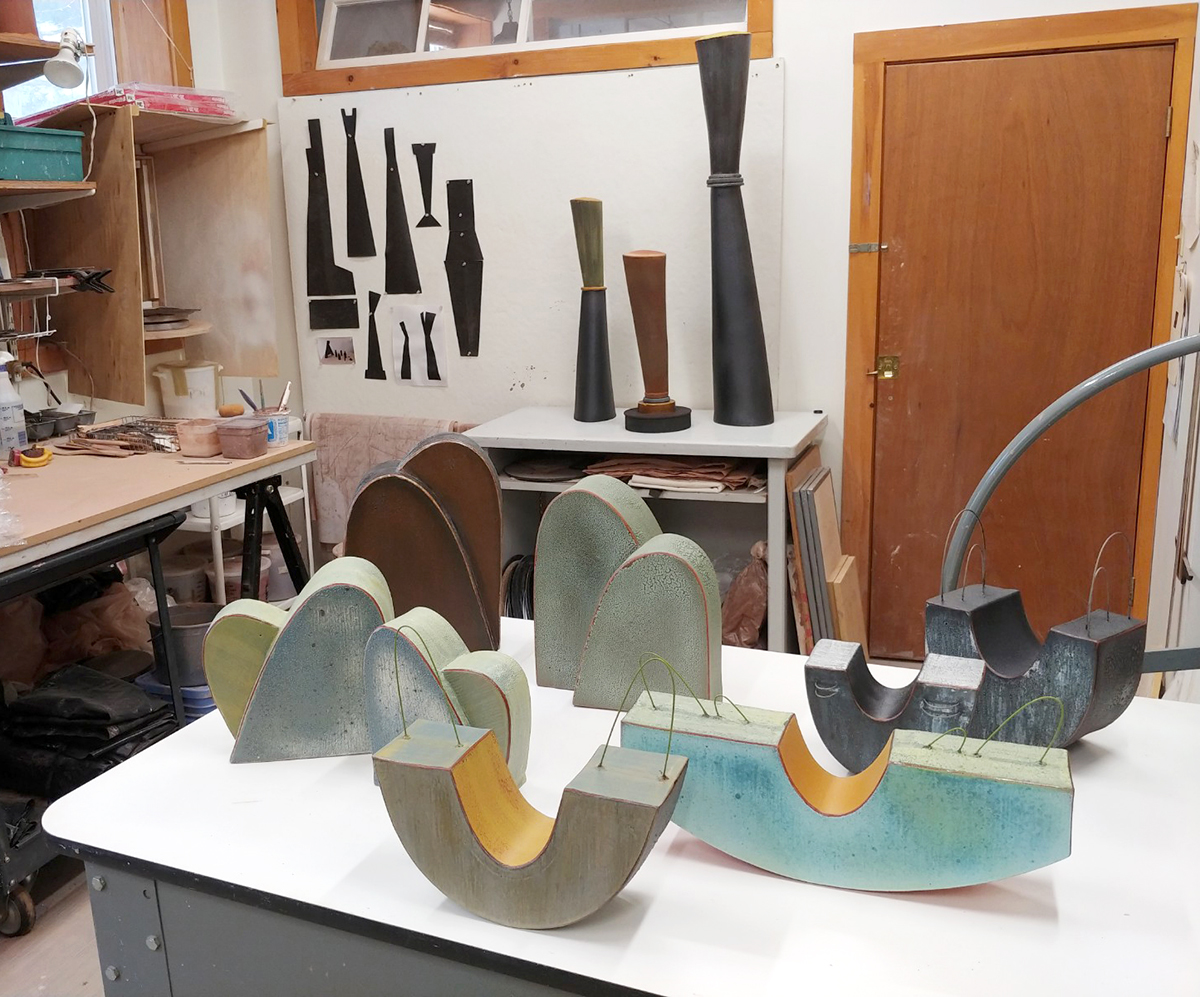
This is an image of my work space at Sawyer Street Studios in South Portland ME, a ceramics facility I purchased and renovated with three other women artists in 1988. We’re still going strong after all these years! The work you see here is from my most recent firing. All of my pieces are slab constructed with glazes and slips applied in layers, fired to 04 in oxidation. My reference is to various kinds of structures, some as small as letters of the alphabet, others large scale architectural and industrial forms. The idea is to refer rather than replicate. Tarpaper is an integral part of my idea generation and working process, used as maquette, template and mold. The patterns you see in the back left help me to envision 3-D form. A visit to my website will show you closer images of pieces, most of which are primarily clay, but some incorporate other materials.
Christoph Friedrich
Session 1 Iron—From Technique to Ideas
In German usage, a metal designer is also called an artist blacksmith—that means blacksmith and art, or craft and design, or hand and head, or art and skill.
As an artisan, it is very important to me personally that I first make sure that I have the techniques to realize my ideas with my hands. So, on the drawing board, I already have certain steps of realization in mind. However, this is not always possible, especially if the idea is completely new. I first try to create the idea in a different, softer material and then use a metal model to get closer to the original. Many of my works were created as models before I made the original in the workshop.
I would have liked to follow this approach in my workshop at Penland: Get to know techniques and then create an idea from head to hand.
Jeana Eve Klein
Session 1 Textiles—Say It Softly
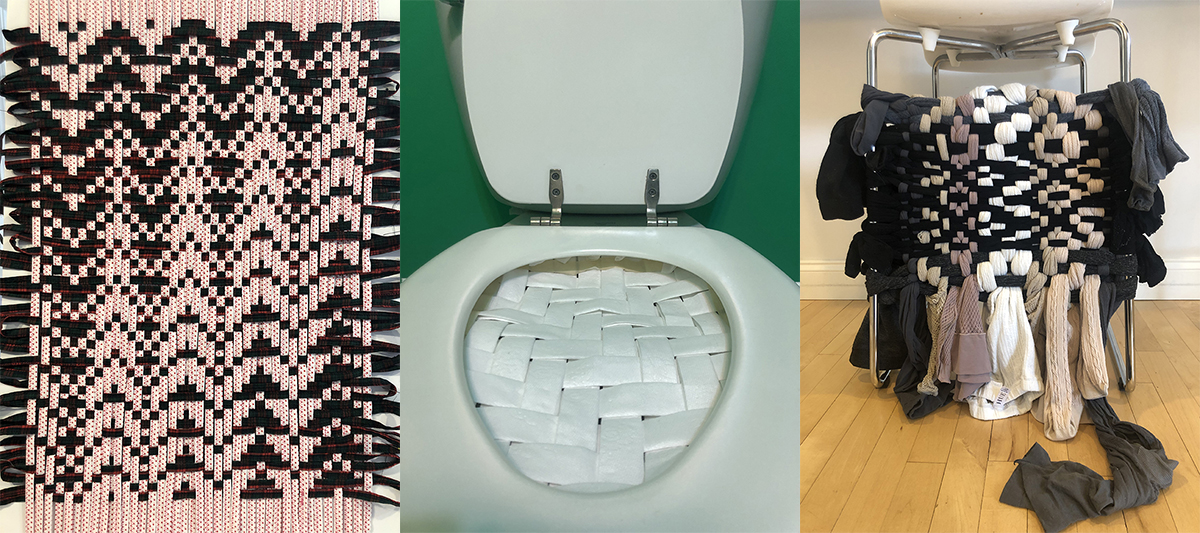
In an alternate reality, right now I would be immersed in the intensity of studio practice, the richness of relationships, and the abundance of fantastic food that is Penland. I would be teaching Say It Softly, a workshop driven by my own studio work of the last three years. We would be translating words into physical textile forms with processes like appliqué, reverse appliqué, piecing, embroidery, and embellishment (with loads of sequins). Instead, I am making masks and preparing to teach weaving at Appalachian State University as it was never intended: online.
I can only mentally justify my creative practice right now if it in some way gives something to others. Part of that drive has resulted in masks to give away (though certainly not at the same mass scale as so many artists right now), but a larger part has been modeling for my weaving students that the woven world is bigger than looms.
When my students at Appalachian State University left for spring break, their first major projects were almost finished on their looms. They had just started learning the language of weaving in January, and were ready to start speaking in visual sentences when their progress was halted. I promised to show them that weaving can happen anywhere and with anything, and so—in the last two months of the semester—I wove patterns (both complex and simple) throughout my home, using the obvious choices of fabric and yarn, but also things like tights, exercise equipment, spaghetti, and toilet paper in temporary installations. This practice was incredibly cathartic for me. It challenged that side of my brain that craves problem-solving and physical making, while providing what feels like meaningful examples to my students.
Now, I am preparing for the next iteration of weaving instruction, this time 100% online in a condensed five-week summer session. After teaching weaving on treadle looms for years, I am rethinking the entire woven world, and—for the first time—preparing instructional videos for my students. I am also considering how to respond to the incredible limitations of teaching and learning in this format: there is no direct physical interaction, there is no studio community, there is no yarn inventory. I am certain that the class will not be perfect, but I am also certain that my thinking and teaching about weaving will be forever changed.
My studio is a hot mess right now, with half-finished projects scattered everywhere and finished work layered on the walls, as daily reminders of canceled exhibitions. Fabric from my extensive stash is washed, ironed, cut, and/or sewn as it makes the slow transformation into masks. Yarn—from the scrap bin of the ASU fibers studio—blocks my path through the room as I obsessively, painstakingly disentangle and organize it to send off to my summer weaving students. I have no idea when “normal” will return, nor what my “real” studio work will look like when it does. For now, though, I am content to make a tiny contribution toward simply surviving this time, and am grateful to have the space and resources to do so.
Yuri Kobayashi
Session 1 Clay—Expedition to Curves
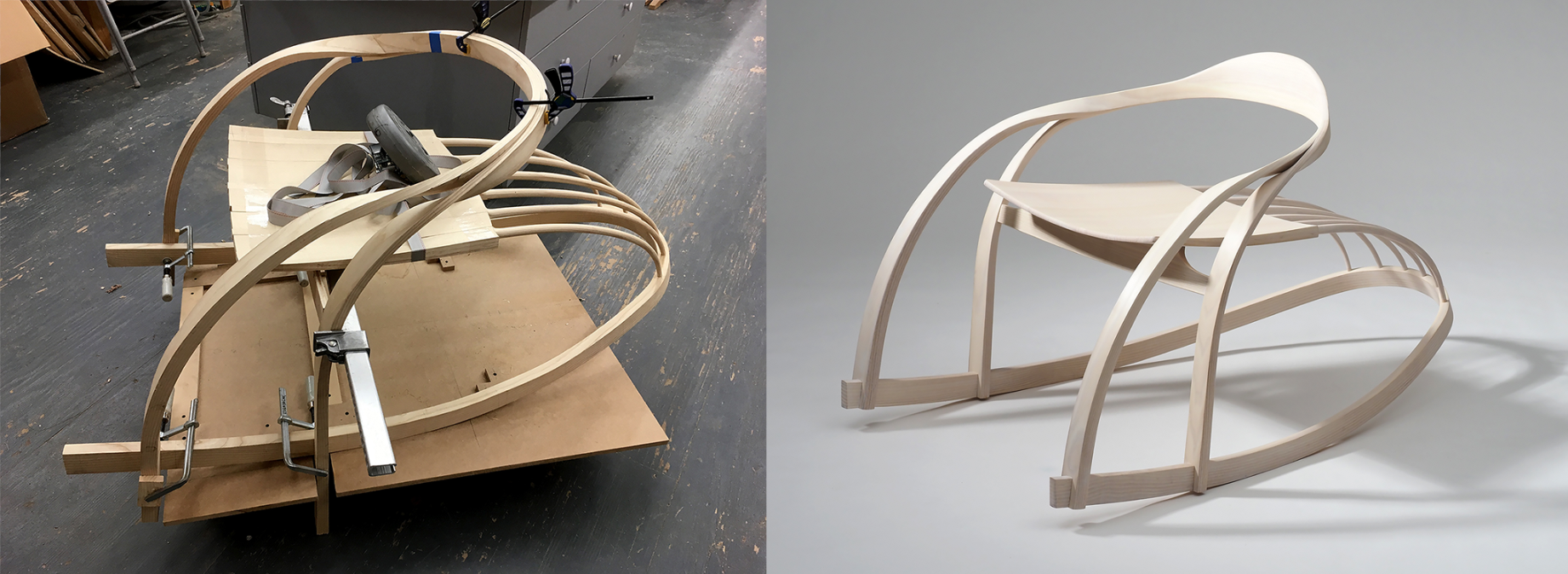
Music and chocolate keep spirits uplifted.
Muse and stupidity approach in the wee hours.
All the cards are held in my hand.
Playing with the game helps to shape the quality of my life.
Born and raised in Japan and now resident in the U.S., I am fascinated by the universality of human nature, on the one hand, and its unique individuality, on the other. My work inevitably reflects on my own personality, experiences, feelings, and beliefs. The discipline of Japanese ethics, aesthetics, and culture was embedded in me before I recognized it. Drawing on these cultural roots, my technical training, and decades of making, I seek to bridge the structure of the traditional craft and the freedom of contemporary art and design.
Whether I am channeling my inner chaos into an abstract sculptural form or a functional decorative object, the challenge is how to embed poetic qualities in work. Fabricating in wood with my own two hands is as essential to me as breathing. It is how I think, how I shape my life, how I relate to the world. In the hope of sharing compassion, encouragement, and inspiration, I play my hand as best I can.
Lindsay Oesterritter
Session 1 Clay—Innovation: One Pot at a Time

Recently my studio practice has slowed down as I ramped up watching my two kids full time. Catching a few hours each day has changed the way I have approached my creative time. Reading more poetry, working on pots for the garden, visiting ideas that have been on the back burner, and enjoying my kitchen pots even more. Unlike a lot of my colleagues, I am finding that because of the kids, I am away from the computer way more than usual. This means my emails take a little longer to get responded to and I am not synced into all the zoom possibilities, but I am engaging in my home space in a way that I have not since we moved here 5 years ago. Anyways, all this to say- I miss you and look forward to face to face connections soon. Be well. Lindsay
Holly Walker
Session 1 Clay—Stretch the Limit
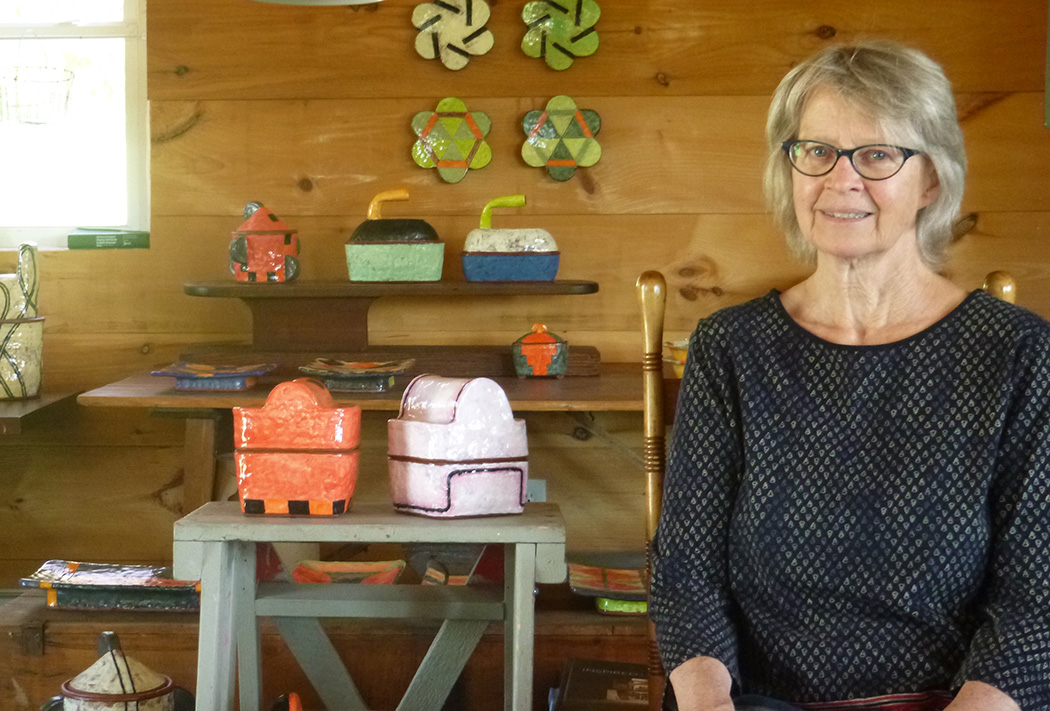
It’s so easy to assume that life will continue as we imagine it will. Maybe the challenge of our changing lives is to become more comfortable with the unknown. After a bit of a roller coaster ride, I feel my equilibrium and buoyancy returning. I seek solace in my studio, and feel so fortunate to have this life of clay already established, and a safe place to explore and imagine. Seeking beauty and working with color is especially uplifting. Daily rambles outside have led me to explore some of the old cemeteries in the area. I find the strolls peaceful, cementing relationships between the past, the present and the future. The two jars fronting this image are the first in a series responding to the grace and simplicity of grave monuments. The new memory I’m adopting is that this space between us all can hold humor, delight, surprise, new solutions, and thinking before action or words.

